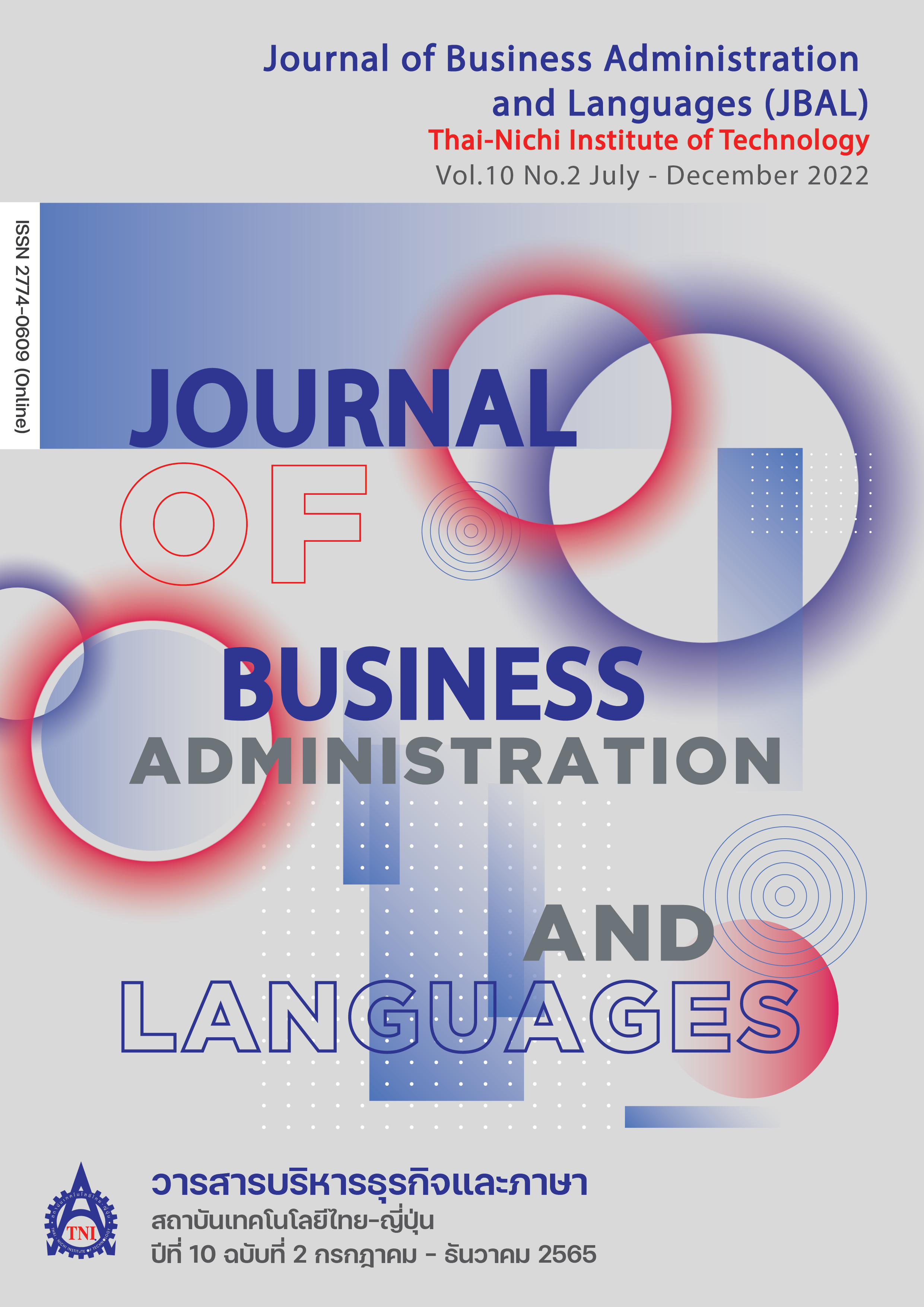Digital Age: Newspapers Organization Management
Main Article Content
Abstract
The goal of this research was to investigate the strategy for modifying newspaper organization management and principles for newspaper organization management in the digital age. The Delphi Method was employed in this qualitative research. (1) the research procedures included the study of literature, relevant research papers, and in-depth interviews to investigate the management adjustment approach of newspapers organizations like Thai Rath and Daily News in terms of policy, commercial, and operational levels as a framework for managing the newspaper media organizations, (2) the analysis of documents and in-depth interviews conducted with 21 experts, (3) the development of criteria for media organization management, (4) the evaluation and certification of the results of newspaper organization management.
Based on the results of the study of newspaper media organization adjustment strategies of Thai Rath in the aspect of the policy level, there was an investment in technology to use news management system. In terms of the business level, the organization itself has adopted an aggressive marketing strategy. Additionally, for the operational level, there has been some preparation of personnel to be ready for the organization to reach its success. Besides that, for the strategies of the Daily News at the policy level, there was an implementation of the principle of stabilization to strengthen online media. At the business level, the organization aims to create quality. Moreover, at the operational level, there was an adjustment in the organizational structure and building values for pride and loyalty.
The findings support the criteria for newspaper organization management in digital era. (1) dynamism, changes in aims and media organization tactics, (2) technology, (3) new newspaper design and structure for a contemporary organization, (4) in terms of Human Resources, it is managed in line with the factors and the environment which is a powerful tool for transforming media management.
Article Details

This work is licensed under a Creative Commons Attribution-NonCommercial-NoDerivatives 4.0 International License.
Article Accepting Policy
The editorial board of Thai-Nichi Institute of Technology is pleased to receive articles from lecturers and experts in the fields of business administration, languages, engineering and technology written in Thai or English. The academic work submitted for publication must not be published in any other publication before and must not be under consideration of other journal submissions. Therefore, those interested in participating in the dissemination of work and knowledge can submit their article to the editorial board for further submission to the screening committee to consider publishing in the journal. The articles that can be published include solely research articles. Interested persons can prepare their articles by reviewing recommendations for article authors.
Copyright infringement is solely the responsibility of the author(s) of the article. Articles that have been published must be screened and reviewed for quality from qualified experts approved by the editorial board.
The text that appears within each article published in this research journal is a personal opinion of each author, nothing related to Thai-Nichi Institute of Technology, and other faculty members in the institution in any way. Responsibilities and accuracy for the content of each article are owned by each author. If there is any mistake, each author will be responsible for his/her own article(s).
The editorial board reserves the right not to bring any content, views or comments of articles in the Journal of Thai-Nichi Institute of Technology to publish before receiving permission from the authorized author(s) in writing. The published work is the copyright of the Journal of Thai-Nichi Institute of Technology.
References
Champion, K., Doyle, D., & Schlesinger, P. (2011). Quality, diversity and innovation: Their role in the economic functioning of the media industries. Retrieved from https://www.gla.ac.uk/media/Media_307054_smxx.pdf
Dawson, R. (2010, October 8). Newspaper extinction timeline [Web log post]. Retrieved from https://rossdawson.com/frameworks/newspaper-extinction-timeline/
Erdal, I. J. (2011). Coming to terms with convergence journalism: Cross-media as a theoretical and analytical. Convergence: The International Journal of Research into New Media Technologies, 17(2), 213–223.
Hayes, J. (2002). The Theory and Practice of Change Management (4th ed.). London, England: Palgrave Macmillan.
Hultin, J., & Skog, D. (2011). The digitalized newspaper organization: An identity crisis in the midst of the challenges of being early adopters of converged digital services. (Bachelor’s thesis). Retrieved from http://umu.diva-portal.org/smash/get/diva2:425990/FULLTEXT02.pdf
Jagreerat Sangvari, Prachyanun Nilsook, & Pallop Piriyasurawong. (2014). The development of digital television station for education quality criteria (in Thai). Kasem Bundit Journal, 15(2), 75–88.
Kaluza, B., Blecker, T., & Bischof, C. (1999). Implications of digital convergence on strategic management. In S. B Dahiya (Ed.). The Current State of Economic Science (pp. 2223–2249). Rohtak, India: Spellbound Publications.
Kathathorn Asawajiratikorn. (2009). Success of a newspaper business of Thai Rath. (in Thai). (Master’s thesis, Kasem Bundit University). Retrieved from https://dric.nrct.go.th/Search/SearchDetail/236914
Lawson-Borders, G. (2003). Integrating new media and old media: Seven observations of convergence as a strategy for best practices in media organizations. International Journal on Media Management, 5(2), 91–99.
McQuail, D. (2010). McQuail's Mass Communication Theory (6th ed). London, England: SAGE Publications.
Nipapan Jensantikul. (2017). Utilizing the Delphi Technique for Research. Kasetsart University Political Science Review Journal, 4(2), 47–64.
Picard, R. G. (2011). Digitization and media business models. In R. G. Picard (Series Eds.), Mapping Digital Media: Digitalization and Media Business Model (p. 2). Retrieved from https://www.opensocietyfoundations.org/uploads/226aec3a-9d1f-4cc0-b9a1-1ad9ccedda55/digitization-media-business-models-20110721.pdf
Sakulsri Srisaracam. (2011). Social media and the changing of news reporting process (in Thai). Retrieved from National Research Council of Thailand (NRCT) website: https://doi.nrct.go.th/ListDoi/listDetail?Resolve_DOI=10.14458/DPU.res.2011.41
Saltzis, K. V. (2006). Media convergence in news organisations: How digital technologies affect journalists and the management of news productions. (Doctoral dissertation). Retrieved from https://hdl.handle.net/2381/34611
Srirth Pakdeeronachit, Chanonya Chaiwongroj, & Prit Supasetsir. (2004). The content analysis on health in Thai newspapers (in Thai). Institute of Culture and Arts Journal, 15(1), 1–6.
Sutthikiat Phumphattahnasuk. (2010). A study of strategic management of the radio station FM 93.5 yes radio retro program (in Thai). (Master’s thesis). Retrieved from http://www.sure.su.ac.th/xmlui/handle/123456789/9668


